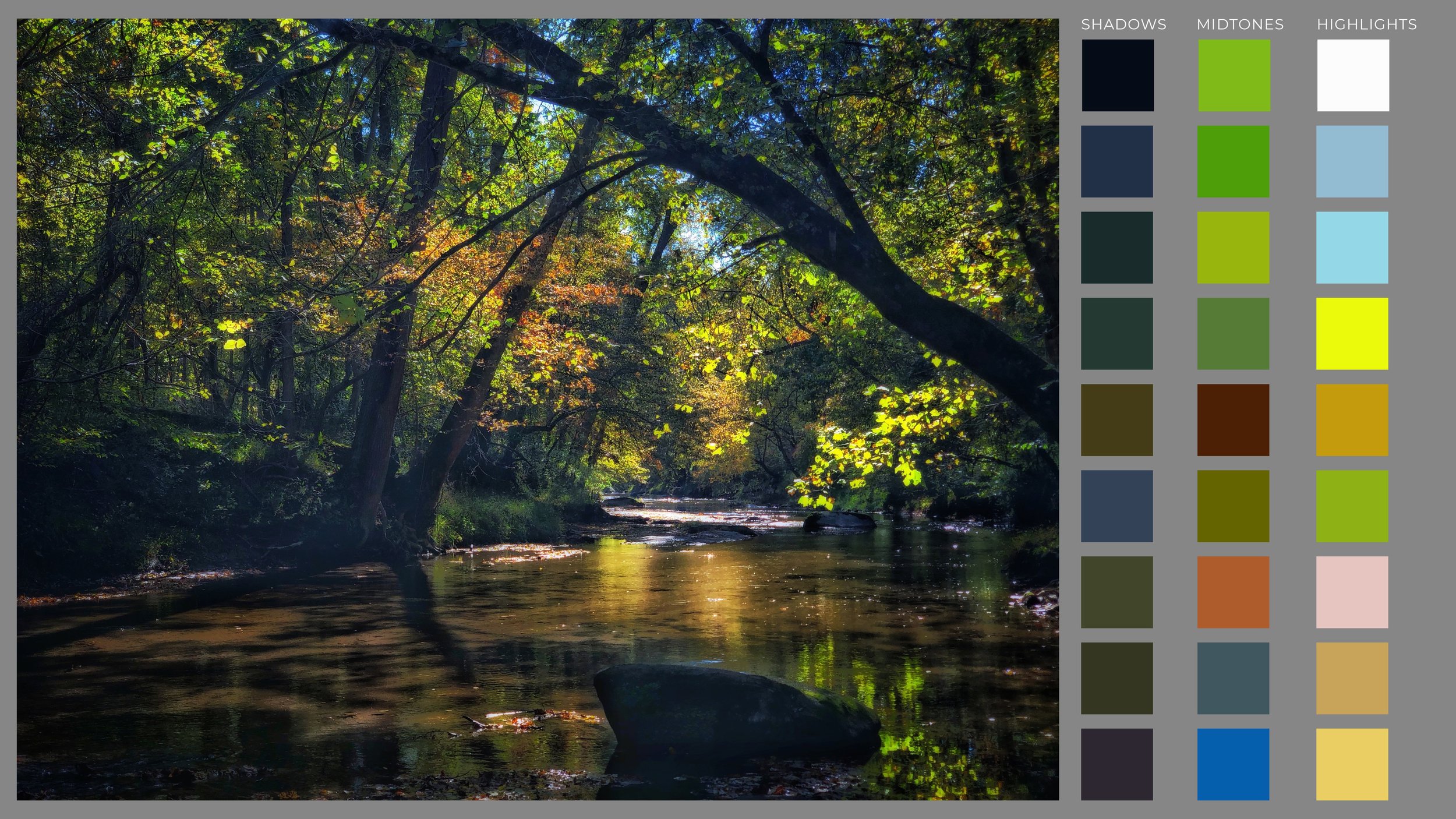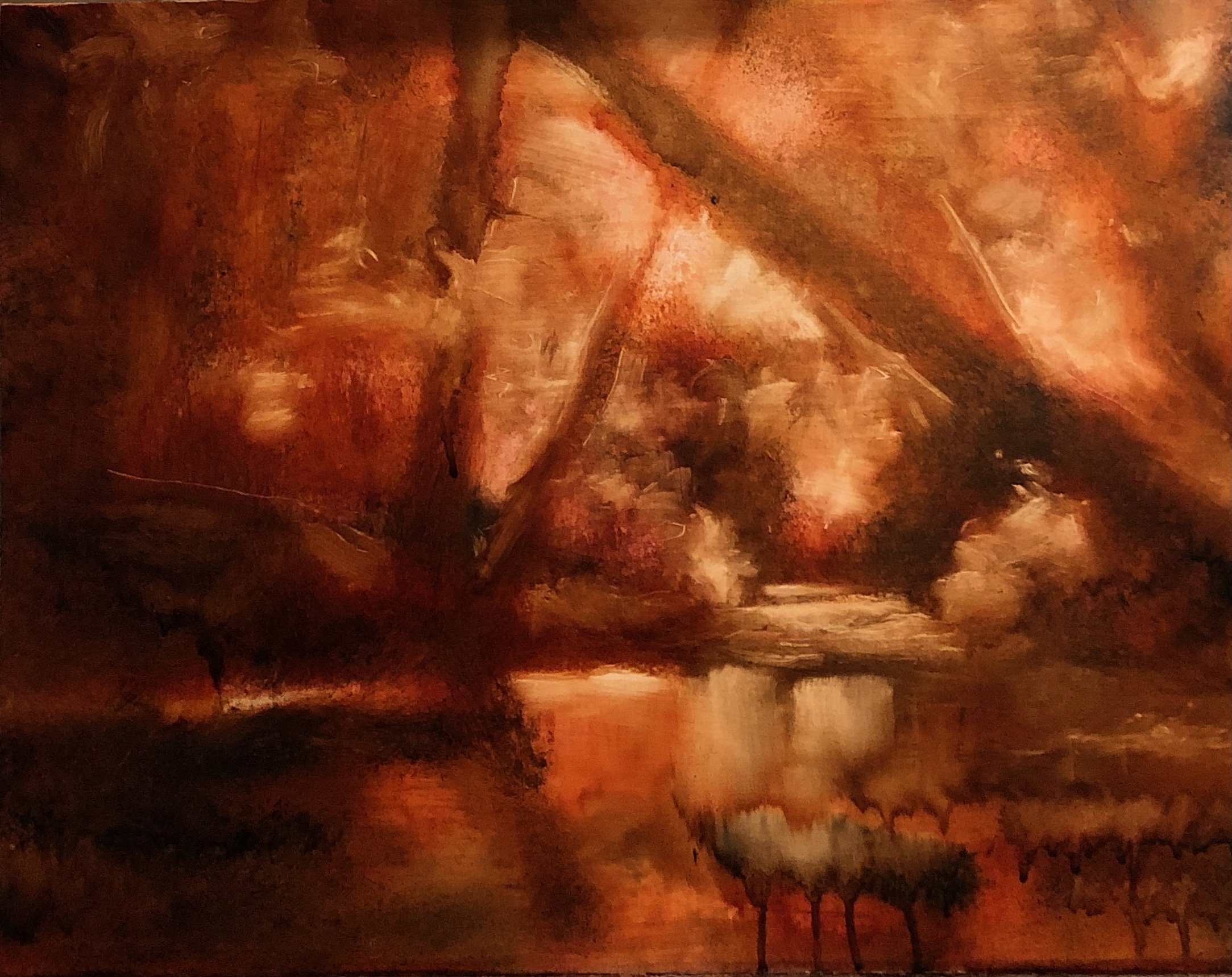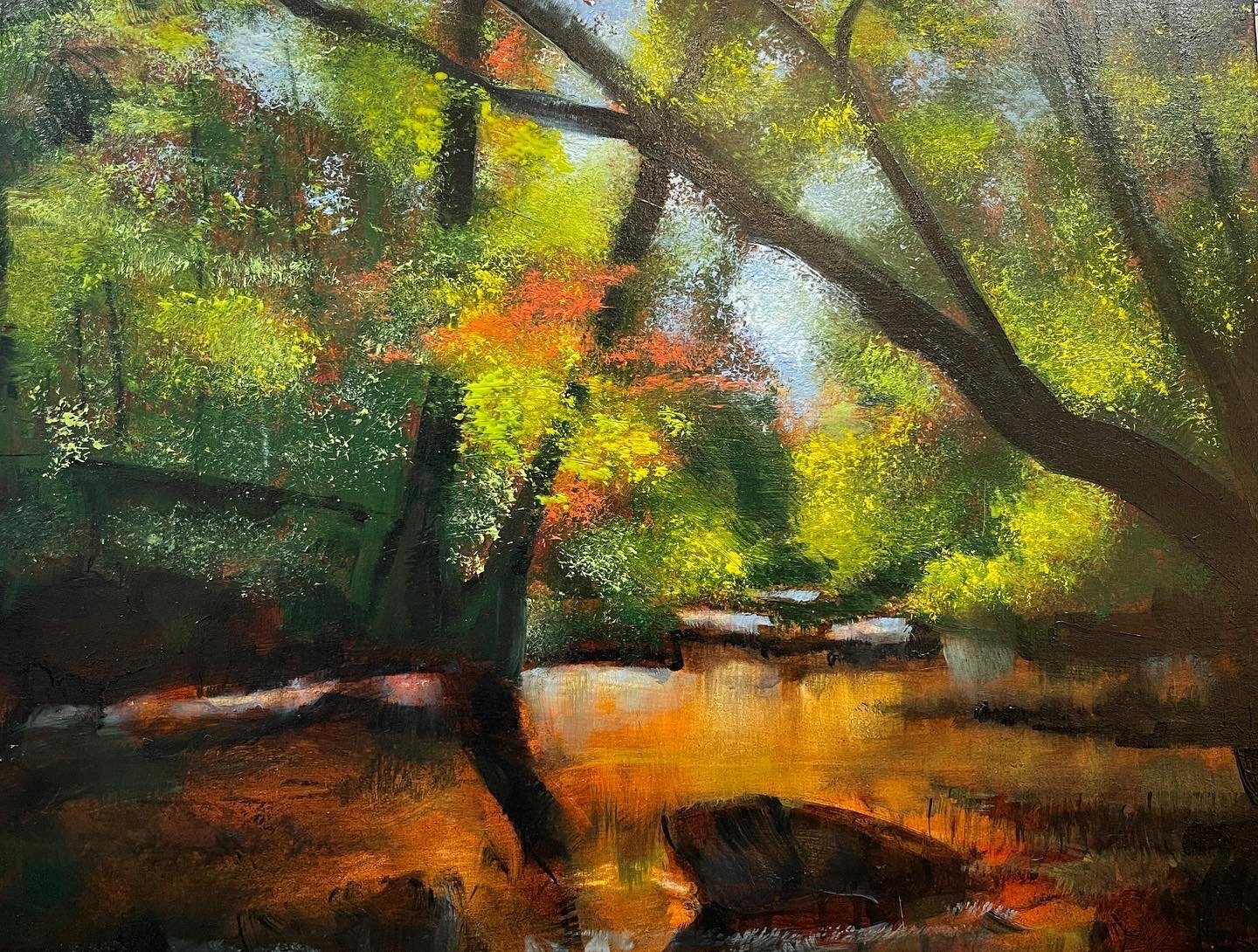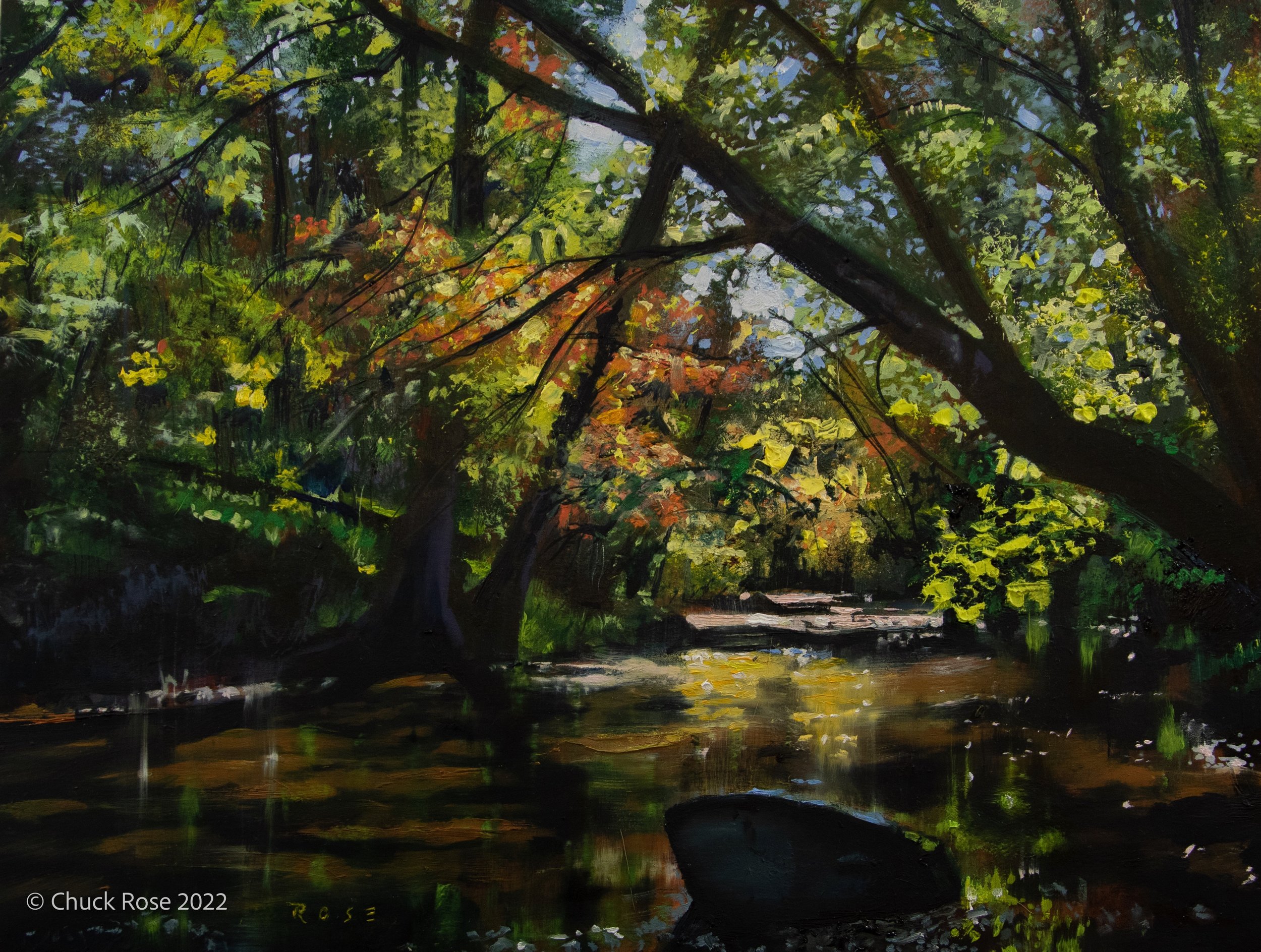How I Work
I am primarily a studio painter. Which is ironic because I paint landscapes most of the time. Even more ironic is, as I said on my about page, what satisfies me most as a painter is capturing fleeting moments of light that only last for a short time. Sometimes only an instant. But I want the result to look as though I painted it en Plein Air. I love a painterly look filled with brush strokes.
My studio in the evening. My digital workstation is on the left, and my painting rig to the right. My glass topped palette sits in between with the ever-present roll of Viva paper towels ready to clean brushes and palette knives. “Malta Olive Groves” is on the screen being prepped to share, and “Plough” is on the easel in the middle of its restoration.
I have been a graphic designer of one type or other for almost 40 years. So I approach oil painting with many of the same goals I apply to my design work. My personal goal as a painter is to create an image that means something to me, and makes the viewer want to be there. To achieve that I start designing the painting long before I pick up a brush.
Please don’t get me wrong. I have nothing but respect for my fellow artists who paint en Plein Air. I do it occasionally and hope to more in the future. Painting from life is always a good thing.
Painting en Plein Air
A 3-hour study at the National Arboretum in Washington, D.C. The light and shadows continually change as the sun climbs through the sky.
My process is a bit more spread out. I think about making a painting in terms of creating an image, not just looking at something and trying to capture it on canvas. Whether that be a photo or painting from life.
Here are the basic steps I follow for representational landscape painting:
1. Hunt
Step one is finding a location rich with potential paintings. If I am lucky, I stumble into these. It’s the main reason I carry an iPhone. Should I be walking down the street and see in nature one of those moments that make the world look amazing, I pull out my phone and start shooting with great intent. Ask my poor wife. It happens all the time.
2. Gather
With an iPhone or a DSLR I take as many photos as it takes to get the exposure and composition right. I am shooting with a painting in mind. My goals for that photo, as a painter, are different from that of a professional photographer or the average person, who is usually capturing a moment as a reminder. My goals require an image that will look like it was painted from life, is well lit, and well composed. When I share my photos I often hear, “Your photographs look like paintings.” That’s because most of the time I am shooting with a painting in mind. I am already doing a lot of the pre-planning work at this stage. I’m thinking about color, composition, and exposure. I always shoot in manual mode. Even when using my phone I don’t settle for what the camera’s sensors give me by default. Modern cameras, as good as they are, tend to shoot too ‘hot’, or a little over exposed. This can give you highlights that are blown out and lacking detail. Or the opposite, the shadows will go totally dark, eliminating all the shadows. As the old saying goes, “Garbage in, garbage out”. If I am using photography as reference the quality has to be the best I can make it.
If I am on a hunt that I have planned, (there are some good stories there) I will ‘Gather’ using an iPhone and a DSLR. Often I will shoot time lapses which provide hundreds of individual images of a subject as light moves across it, or a storm rolls in. That takes a little time. It’s called “Discovery work” in the corporate world. You must be in a place for some time to figure out where, and when, the paintings are.
Time Lapse Photography
Here my camera is set up at Mesa Verde National Park in Colorado. A stunning vista. A good time lapse can generate hundreds of choices for painting reference as well as video content.
3. Edit
Editing is the second half of talking the picture. The first part happens in the camera, but the second part happens on the computer or phone. I never use a photo straight from the camera as a reference for painting. But I will leave the details of that for another post.
I am often told my photos look like paintings.
That’s because I have a painting in mind when I take the photo. I expose the image in such a way as to have a complete range of values in the highlights and the shadows. plenty of detail to choose from when painting.
4. Design
Creating a composition from a single or multiple images is based on the aspect ratio of the final painting. I start by looking at the size and aspect ratio of the surface I am using. The aspect ratio will determine the composition, and the size determines the ‘resolution’, or number of brush strokes necessary to solve a visual problem. For example, in a 6” x 6” seascape, a breaking wave could be painted in just a few strokes. In 6’ x 6’ painting, that is a much different problem to solve requiring much more painting and technique.
5. Paint
Color mixing – Understanding the color harmony of the scene and being able to mix the colors in oil. To create and control the palette, which in turns controls the effect of light.
Making marks – I typically do a painting in about five layers or sessions. I sometimes will do an underpainting in a burnt umber to establish my drawing, but lately I have been doing color block-ins that capture the big shapes, colors, and values.
Wash, rinse, and repeat. - With every painting session, even if not finished I leave the painting resolved. Meaning if I stopped, you might think the painting is done, but very loose. With every session I refine the details. This doesn’t happen equally across the painting. I like to think of it as pulling the painting into focus with every layer until I have the design I was seeking.
Signing – When all the shapes are the right size, in the right place, the right color, and right value, the signature can be applied.
In my process, painting is the last thing I do.
Painting progression from reference photo to final painting









Click or tap the thumbnail images to progress through the painting.
Even though this photo was taken in a few seconds I would argue that it took me 20 years to capture it. I lived near this creek for that amount of time and observed it almost everyday. In that period I came to know how the light behaves during different seasons, when the leaves would have the right combination of colors, and most importantly, what time of day the sun would turn this spot into a magical scene of light and color. By the way, it’s 2:00 PM in early August.
Commissions
The outline above describes a process, but it also describes what I think makes my work worth having in your home or business. As much of a thrill applying the paint is, the conceptual and the spiritual are just as, if not more so, necessary to create a good painting. It’s not about copying a photo, it’s about the quality of reference from which I work.
If you are interested in discussing a project where I can bring all three together, please drop me an email: chuck@chuckrosepainter.com. I would be more than happy to discuss it with you. Or, become a collector by shopping in the store and signing up for the newsletter. I promise not to pummel you with email. Right now the plan is to do three email newsletters a year.


